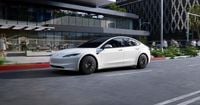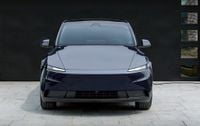Tesla, the company that once electrified the automotive world with its promises of affordable, cutting-edge electric vehicles, has unveiled its latest gambit: the “Standard” versions of its Model 3 and Model Y. Announced in early October 2025, these new trims are meant to be Tesla’s answer to mounting competition, the end of federal EV subsidies, and a changing market. But for many observers—including some of Tesla’s most ardent supporters—the move smacks more of strategic retreat than bold innovation.
The formula behind these new Standard trims is simple enough: take the existing Model 3 and Model Y, strip away a host of features, and offer them at a lower price point. The Model 3 Standard now starts at $38,630, and the Model Y Standard at $41,630, including destination fees. Yet, as reported by Quartz and U.S. News & World Report, these prices still place them squarely in competition with a growing field of rivals—many of which offer more for less.
For anyone who’s tracked Tesla’s journey, the unveiling of these models is tinged with irony. CEO Elon Musk has been promising a truly affordable, clean-sheet $30,000 Tesla for years. As recently as January 2025, Musk reaffirmed plans for a next-generation small crossover that would “start production towards the end of 2025.” But the Standard Model Y is not that long-awaited vehicle—and, as Quartz notes, Tesla has internally abandoned its $25,000 model, shifting its focus toward robotaxis and artificial intelligence.
So what exactly do buyers get—or, more accurately, not get—with these new Standards? The list of omissions is extensive. Gone are the leather seats, ambient lighting, rear passenger screen, ventilated front seats, heated rear seats, HEPA filter, sound-insulating double-paned acoustic glass, and even the humble AM/FM radio. The Model Y Standard loses its panoramic glass roof (though the Model 3 keeps it), and both shed the adaptive high beams and the refreshed design’s Cybertruck-inspired light bar. The new Model Y also reverts to passive shock absorbers, scrapping the improved suspension from the latest refresh.
Performance-wise, the Model 3 Standard accelerates from 0 to 60 mph in 5.8 seconds, while the Model Y Standard does it in 6.8 seconds. Both offer a competitive maximum range of 321 miles and can charge at up to 225 kW—fast, but not class-leading. However, the cars lose about 20 miles of range compared to previous trims, and, perhaps most notably, the popular Autosteer lane-centering feature has been axed unless buyers pony up $8,000 for the “Full-Self Driving (Supervised)” package. As U.S. News & World Report points out, the name is misleading; the system is not truly autonomous, and removing basic driver assistance from a so-called affordable model raises eyebrows.
Inside, the cost-cutting is palpable. There are only seven speakers instead of fifteen. The power front seats lose their physical controls and must be adjusted via the touchscreen. The console is simplified, and the steering wheel is now manually adjustable—an improvement, some say, over the previous system’s cumbersome interface. The Model Y’s new front fascia is plainer, and both models ride on jet black 18-inch wheels that look somewhat undersized on the larger Y.
Despite these rollbacks, Tesla’s new Standards are entering a far more crowded and competitive marketplace than when the Model 3 debuted in 2017 or the Model Y in 2020. The Chevrolet Equinox EV, for instance, starts at $34,995 and offers 319 miles of range, a more user-friendly interface, and a more upscale cabin. The Nissan Leaf, while smaller, boasts over 300 miles of range and comes in at $8,000 less than the Model 3 Standard. Hyundai’s Ioniq 5 SE rear-drive is pricier, but it comes with rebates and a host of creature comforts that Tesla’s stripped-down models now lack.
What’s more, the timing of Tesla’s announcement coincided with the expiration of the $7,500 federal EV tax credit at the end of September 2025—a move that effectively erased any price advantage the new Standards might have offered. As Quartz reports, “the ‘cheaper’ versions cost about $5,000 less than the next trims up, but they arrive just a week after the federal EV tax credit expired—effectively wiping out the savings before anyone could feel them.” Tesla’s stock reflected the market’s skepticism, dropping around 4% after the launch and erasing gains from earlier teaser videos.
Industry analysts are also unimpressed. Dan Ives of Wedbush Securities, long one of Tesla’s most bullish Wall Street supporters, wrote, “We are relatively disappointed with this launch as the price point is only $5k lower than prior Model 3’s and Y’s.” He called the move “a step in the right direction” but noted that affordability remains “similar to when these vehicles had the tax credit applied.” For many, that’s analyst code for “not enough.”
To make matters more complicated, Tesla faces mounting pressure from all sides. In the U.S., GM and Ford are rolling out EVs in the $30,000 range. In China, BYD’s small cars start at $8,000, and its Seagull model comes in at $25,000, while Xiaomi’s YU7 is priced at $35,000. In Europe and China, Tesla’s market share is slipping, and as Quartz observes, “European buyers have cooled on Musk himself after his overt flirtations with far-right politics.” The competitive landscape is shifting, and Tesla’s once-unassailable position is looking increasingly vulnerable.
Meanwhile, the company’s focus appears to be drifting toward artificial intelligence and autonomous vehicles. The same day as the Standard models’ launch, Tesla released FSD 14.1, a major update to its Full Self-Driving software, promising smarter detours, better emergency vehicle detection, and fewer driver interventions. Ives argues that “the AI valuation will start to get unlocked in the Tesla story and we believe the march to an AI driven valuation for TSLA over the next 6-9 months has now begun.” He projects Tesla’s market cap could reach $2 trillion by 2026 in a bullish scenario, hinging on the success of robotaxis and autonomous technology.
Yet, for all the talk of AI and the future, the reality on the ground is more prosaic. The new Standard trims seem less like a leap forward and more like a way to keep assembly lines humming and delivery numbers up while Tesla’s next act is still in the wings. As U.S. News & World Report puts it, “It’s hard to see these stripped-down Model 3 and Model Y variants as a step towards the future rather than an attempt to eke out a little more mileage from old designs.”
Adding another layer of intrigue, Tesla shareholders are set to vote on Elon Musk’s proposed $1 trillion pay package in less than a month. Since the vote went public, Tesla has issued a steady stream of positive news: a $1 billion share purchase by Musk, early FSD releases, and now the launch of “mass-market” cars that sound good in headlines, even if they don’t change the substance of the product lineup. Some see this as narrative management aimed at keeping sentiment—and the stock price—buoyant heading into a major payday.
In the end, the launch of Tesla’s Standard Model 3 and Model Y serves as a telling snapshot of the company’s current crossroads. Once the undisputed leader in electric vehicles, Tesla now finds itself playing defense, competing on price rather than possibility. For consumers, the new Standards may be a small step toward affordability, but for the company, they’re a reminder that the future isn’t always what it used to be.





